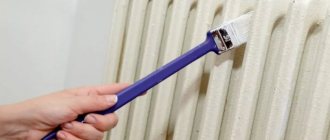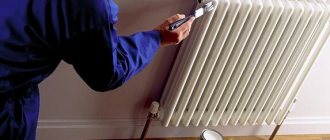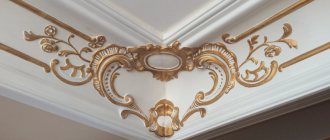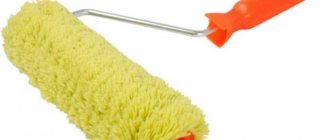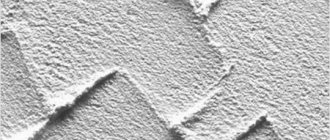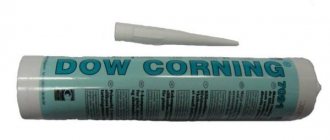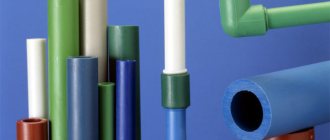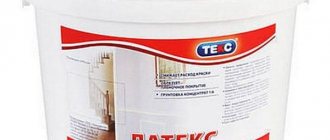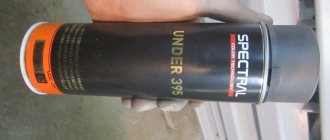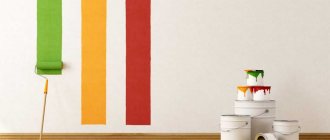The entire heating system of residential and industrial premises requires the application of a protective layer using dyes at least once every five years. This manipulation will prevent the destruction of heating communications due to exposure to external unfavorable factors, corrosion, and will also maintain a pleasant appearance. Pipe paint must meet certain requirements and perform a number of tasks assigned to it. The market for modern building materials offers consumers a large selection of products that differ in both price and performance properties.
How to choose the right coating for radiators
Any specialist involved in the repair of pipes and radiators, when asked what paint is best to paint heating radiators, will answer:
- The paint coating must be thin and with maximum thermal conductivity of the paint layer in order to ensure good heat transfer to the room air;
- The paint must provide protection to the metal surface;
- The coating must withstand heating temperatures of up to 150°C for high-pressure radiators and 120-130°C for conventional steel or cast iron batteries.
For your information! Paint for cast iron radiators, in addition to all the above conditions, must have high fluidity and low viscosity.
Even after priming, the cast iron surface remains quite rough and porous, so aerosol molds are the best choice for cast iron. The radiator is painted in several passes, each layer must be thoroughly dried and any stains removed. As a rule, heat-resistant spray paint for radiators has a very low odor, but it is necessary to paint installed radiators only with the windows open, in dry, warm weather.
For conventional steel and aluminum heating radiators, the use of aerosols allows you to apply a thin layer to the most hidden places where it is difficult to reach with a brush or roller. In addition, a thin layer of enamel dries 2-3 times faster, which means that even if there is a slight odor, it will disappear in half an hour. The smell from a thick layer of enamel on an organic solvent will stay on the radiator for 5-6 hours, for oil or pentaphthalic paint - for several days.
Heat resistance and volatility of paint for heating appliances
First of all, it should be noted that odorless paint for heating radiators does not exist in nature. Any enamel has a slight but pronounced odor. Even paints for heating appliances, interior wall decoration based on acrylic polymers, or simply water-based brands also have an odor.
Ask a store clerk or building materials showroom for odorless radiator paint, and he will give you a whole list of heat-resistant enamels with the word “odorless” on the label. Actually this is not true. If you take the most seemingly safe water-based paint and paint a heating radiator at a temperature of 30-45°C, the smell will be quite unpleasant.
Imported, for example, Polish, Czech or German paints for interior work and heating radiators may have virtually no odor or have a light pleasant aroma, for example, of fresh ice cream or sawn wood. But this does not mean that such odorless radiator paint is absolutely safe and cannot affect your well-being.
Production technology makes it possible to skillfully mask the real smell of paint, therefore, imported paints and varnishes use a special index of volatile organic compounds, or in the abbreviated version - VOC. Instead of a vague concept of odor, VOC precisely defines the maximum content of volatile organic compounds that will have to be inhaled when painting a heating radiator. Even for safe, and practically odorless, acrylic enamel for heating elements, the standard allows no more than 130 g of organic volatile substances per liter of material.
The easiest way is to determine the heat resistance of the paint and varnish material. The label of a can of enamel for heating systems always indicates the maximum temperature of the radiator at which the coating can be applied and the upper limit for heating the battery. For central heating systems, the coolant temperature rarely exceeds 100°C, but in private homes, part of the pipes that drain hot water from the boiler heat exchanger can heat up to 120-130°C.
Radiators and convectors
In some city apartments, so-called convectors were once installed. These are metal pipes with frequent and thin, usually aluminum fins. So, such heating devices are not painted at all, due to the fact that thin plates, when painted, significantly lose their design heat transfer characteristics.
Heating manifold with casing.
According to technology, a set of household convectors must include a protective, removable metal casing. That's when you can paint it. Although, to be honest, the efficiency of old heating devices of a similar design leaves much to be desired and, by and large, it is advisable to replace them altogether.
Most often, owners of classic cast-iron radiators are puzzled by the question of how to paint a heating radiator. After all, such units are initially sold unpainted. Not to mention those batteries that have been standing for several decades and are covered with truly centuries-old layers of paint.
Painting heating pipes.
Modern bimetallic, aluminum or copper radiators are usually coated with high-quality powder coating at the factory. And here we can talk about repainting only if the battery is seriously scratched or the person spared money and bought a low-quality product with a poor-quality coating.
This sometimes happens with Chinese batteries. We will also talk about how to paint heating radiators made of non-ferrous metal.
Heat transfer from heating devices.
Oil paint for heating pipes
This material is made using oils of organic origin and in previous, not so distant times, it was almost the only option for painting metal products. This material copes well with the function of “paint for heating pipes”. It has excellent hiding power, is resistant to abrasion and high temperatures.
Despite its advantages and low cost, this paint and varnish material has been completely abandoned in modern times.
This is justified by the following arguments:
- a specific and unpleasant odor that accompanies painting work.
- Low thermal threshold after drying: when the radiator battery is heated above 80 degrees, it can emit an unpleasant odor.
- The hiding power of the paint is so high that the resulting thick layer applied to the battery significantly reduces heat transfer, which reduces its efficiency.
- Due to the consistency of oil paint, uniform application on the product is almost impossible.
- During use it is subject to tarnishing and yellowing.
- Long drying time, which entails an increase in the duration of work.
As can be seen from the above, oil paint has a number of significant disadvantages.
Features of surface and enamel for painting
To paint the surface of a slab, you do not need to have special knowledge; it is enough to have basic information and take into account some features when painting yourself. But it is worth considering the fact that ordinary enamel is not suitable for painting the surface of a gas stove, since when exposed to high temperatures, such paint very quickly deteriorates and peels off.
You can paint the stove at the place where it is installed, but it is still advisable to temporarily disconnect the device from the gas supply network.
First, let's look at the type of surface of gas stoves. So, most often, in the manufacture of gas appliances, alloyed stainless steel is used. The metal has a high degree of resistance to high temperatures.
This surface is painted with special enamel to protect the coating from corrosion and give the gas appliance a beautiful appearance.
Before you start painting the gas stove, you need to remove the old layer of paint. To do this, you can use a metal brush, sandpaper or a chemical agent. Only after this can you start painting the old surface.
Plain enamel or acrylic paint is not suitable for painting the surface of a gas stove. Because when exposed to high temperatures, it will melt and burn.
The paint for the surface of a gas stove must be resistant to high temperatures and other destructive factors.
As a rule, enamels with the following properties are used for painting:
- Internal stability. Such enamels withstand high temperatures well and do not deteriorate in conditions of high acidity.
- External stability. This protection is designed to protect the metal surface; the enamel protects both from thermal stress and chemical processes.
Such characteristics are necessary for long-term use of a gas appliance in aggressive conditions.
Heat-resistant paint is intended for painting surfaces exposed to high temperatures. This option is suitable for painting the slab yourself
To achieve the required level of stability, enamel for restoration of a gas stove must include the following elements:
- quartz sand;
- soda;
- feldspar;
- borax.
All these elements form a transparent mixture, to which you need to add some more components.
To obtain the most effective paint for devices exposed to high temperatures, the following elements are additionally added during production:
- alumina;
- zinc;
- alkaline elements;
- titanium;
- lead.
This entire composition forms a high-quality paint with high resistance to aggressive factors and imparts a beautiful shine to the painted surface.
It is worth noting that enamels with the addition of cobalt and nickel oxides have better adhesion to the element being painted. This paint can be applied even to a surface that has not been treated with a primer.
Painting stages
It should be taken into account that even the highest quality and most expensive paint will not guarantee a successful result if the surface of the pipelines has not been properly prepared.
Preparing for painting
Painting of pipes should begin only when they are cleaned of dirt, old paint, sanded, degreased and primed. We offer you an indicative algorithm of actions for preparing the heating main for painting.
- remove all dirt and dust from pipes and radiators using a damp cloth or brush;
- clean the surface to a metallic shine with sandpaper or a special drill attachment;
- sanding and degreasing with white spirit or other solvent;
- treatment with anti-corrosion primer.
When preparing pipes for painting, you can use some tips. You can soften old paint and rust using a chemical remover, and then easily remove it with a spatula. It is better to use an alkyd-based primer, because it will improve the adhesive characteristics of the metal surface, and the paint will adhere better to the surface.
How is painting done?
Before painting pipes and radiators, cover the floor under the heating line with film or old newspapers. The wall behind the battery can be covered with masking tape or protected with a sheet of thick cardboard.
Use a small soft bristle brush, foam roller or spray gun. The choice of tool depends on your skills and the specific features of a given heating line.
The tops of the pipes and radiators should be painted first. The bottom of the pipe is painted last, so as not to spoil it with smudges and stains. If you need to apply multiple layers of paint, allow time for each coat to dry.
If you use a spray gun or spray paint, the painting process will go much faster. However, first study the sprayer’s operating instructions and find out from what distance the pigment can be transferred.
Instructions for painting pipes
In order for the result to be pleasing and the painting work not to have to be redone, spending extra money and time, it is necessary to adhere to the technology and follow the recommendations of specialists. The quality of preliminary surface preparation often has a greater impact on the durability and aesthetics of the coating than the choice of paint.
Preparatory work
First of all, you need to take care of protecting the floor, walls and surrounding objects. Old newspapers, magazines, oilcloth or construction film are suitable for this. No matter how hard you try to do everything carefully, paint can still drip or splash in the most inappropriate place. Therefore, it is better to play it safe so as not to think later than to remove paint stains.
On a note! Personal protective equipment will be useful for work: gloves, a hat, work clothes that you don’t mind getting dirty. If you use paint with a smell, you will also need a respirator.
Before painting, the surface of the pipes must be cleaned of dust, dirt and old paint. If the previously applied layers of paint are thin enough, adhere well and do not crack, then you can leave them and just get by with sanding them with sandpaper. Areas with rust need to be treated especially carefully. White spirit or any slightly alkaline solution works well for degreasing the surface.
You can get rid of old paint in the following ways:
- Using a special rinsing solution.
A gel-like liquid is applied to the surface and covered with film. After a short period of time, the old coating softens and is easily removed with a spatula, scraper or wire brush. Paint remover has a strong odor and contains aggressive toxic substances, so you must work with extreme caution.
- Using a blowtorch.
The paint heats up and comes off easily under the pressure of a spatula or similar tool. Can only be used when working outdoors.
- Using a hair dryer.
Due to heating, the old coating easily comes off and can be cleaned off with any sharp object. This method is similar to the previous one, only simpler and safer, and can be used in any room. Due to the ability of metal to quickly give off heat, it is not always possible to warm it up well, so in some cases using a hair dryer will be ineffective.
- Using a drill or grinder with a wire brush attachment.
Old paint can be cleaned off quite quickly, but in hard-to-reach places the brush is powerless; you need to use a narrow spatula, knife or chisel.
The best way to remove paint from pipes and radiators depends on the availability of suitable tools and subjective individual preferences. But in any case, the old cracked coating must be removed so that the new one fits well and lasts a long time. Then the surface is degreased, wiped with a damp cloth and dried.
After complete cleaning of all accumulated layers or when dealing with a new uncoated metal surface, an anti-corrosion primer should be applied if the paint does not contain special protective components. In some cases, the ability of the primer to improve adhesion to the substrate is important. If you use 3-in-1 paint containing a rust converter, primer and color pigments, you can immediately begin applying it without prior preparation.
Important! Regardless of the type of paint and varnish material, work should be carried out in a well-ventilated area. Any paint fumes contain substances that should not be inhaled unnecessarily. Therefore, it is recommended to ensure that pets, children and other family members are away from you during painting.
Applying paint
There are several methods to paint pipes:
- With a brush;
- Roller;
- Spray can;
- Spray gun or spray gun.
Applying paint with a brush is the most common and affordable option. No special skills are required. It’s enough just to take a good brush and, picking up a small amount of paint on the tip, spread it evenly, slowly, over the surface. You must strive to make the layer as thin as possible. This will ensure uniform coverage and no smudges. If the paint shows through, it is better to paint it again later than to apply one thick layer.
Advice! Cheap brushes often have bristles that fall out. Therefore, it is not worth saving on their cost. However, even high-quality specimens sometimes leave hairs. If necessary, lint can be removed with a needle.
It is very convenient to paint pipes and batteries using a special radiator brush. It has a long handle and a curved shape that makes it easy to cover all those hard-to-reach areas.
We recommend: Why the boiler stopped heating hot water: reasons
Using small-diameter foam rollers, it is convenient to paint an openly located pipeline if there is free space around. They are also suitable for the front surface of heating devices. Craftsmen even make special devices from two rollers, allowing not only to ensure an even application, but also to complete the job very quickly.
Sometimes simple scouring pads are used for smooth pipes, allowing you to apply a neat thin layer on all sides. The gloves will, of course, be dirty, but the painting will be completed in no time.
Working with a spray can is the most convenient and fastest. It must be shaken for a minute and can be sprayed onto the prepared surface. Performing smooth zigzag movements, gradually cover the required area. It is important to maintain the distance recommended by the manufacturer and not stay in one place for too long.
Aerosol cans provide a beautiful decorative finish, but are expensive and do not cover hard-to-reach areas well. In this regard, they are usually applied to a well-primed base or after a preparatory background coat of paint.
A professional spray gun is used quite rarely in everyday life, but if there is a lot of painting work to be done, then it is worth acquiring this device. The sprayer allows you to quickly apply even layers with minimal paint consumption and has special nozzles for ease of working with surfaces of the most intricate shape.
Reasons for painting a gas pipeline
Painting of pipes transporting gas to consumers is carried out not only with the aim of giving an aesthetic appearance to communications.
Reasons for painting gas pipelines include:
- highlighting the gas pipeline with color and distinguishing it from other communications;
- protection of metal from corrosion, which significantly increases the service life of gas pipes.
The Gas Supply and Gasification Department has every right to turn off the gas if the communications are not in order.
Paint is the only anti-corrosion protection, so you should not skimp on it; you need to paint it in at least two layers with the consumption specified by the manufacturer
According to the standards adopted at the state level, all highways of multi-storey buildings (up to the valve) are on the balance sheet of the housing and communal services department. In apartments and private houses, the owners must monitor the condition of gas pipes.
Types of paints
What paint should I use for radiators? You are very lucky if you have modern radiators with powder coating at your disposal - it lasts for decades without peeling and almost without changing its color. This paint covers aluminum, bimetallic and steel radiators of various designs. To give it extra strength, the paint is subjected to procedures to make it stronger and more durable. Multi-stage painting has the longest service life.
Painting the batteries is necessary not only to give the radiator a neat appearance, but also to protect it from the environment.
If there are ordinary cast iron accordion batteries or old steel batteries in the house, then they need to be periodically tinted. The paint quickly turns yellow and begins to crumble, exposing the metal and creating all the conditions for the formation of pockets of corrosion. Therefore, the paintwork needs to be updated. It may also be needed when carrying out repairs - what if you decide to paint the batteries in different colors and adapt them to your interior design?
What paint should I use to paint radiators? There are many types of paints:
- water-dispersed – do not emit an unpleasant odor and dry quickly;
- acrylic – they smell like solvents and give a gloss;
- alkyd – resistant, durable, long drying;
- oil paints are not the best option for painting batteries;
- Heat-resistant silver is an excellent option for painting heating appliances;
- silicone-aluminum - excellent in all respects, but very expensive;
- car enamels from spray cans are a reasonable heat-resistant option.
The water-dispersion composition for radiators is completely safe, as it dissolves in water.
Water-based paints are good because they do not have a strong solvent smell, since their base is ordinary water. They dry quickly and are well suited for painting radiators. Some varieties have marks indicating the possibility of painting heating devices.
Don't like matte radiators and want them to shine? Then we recommend that you turn your attention to modern acrylic enamels. They give excellent gloss and have a long service life
Their disadvantage is the smell of solvent, so the premises will need to be ventilated after painting.
Alkyd paints are the most durable. They are resistant to temperature loads, resist abrasion well, and do not change their color for a long time. Some of them can withstand heating up to +150 degrees without turning yellow for many years. Despite the obvious advantages, such paints have one glaring drawback - a strong solvent smell. It manifests itself not only at the painting stage, but also when starting the heating system.
Some consumers note that after drying, the unpleasant odor disappears, but appears already when heating is started for the first time, disappearing after 1-2 days. During these periods, it is recommended to thoroughly ventilate the rooms in which painted batteries are located.
Oil paints are not very suitable for heating radiators, so they have hardly been used recently. They have a strong solvent smell, take a very long time to dry and stick, and the dyes used in them turn yellow over time. In addition, after a year or two, such painting will begin to peel off and fall off, exposing the metal of the heating devices. We do not recommend using this paint for painting heating radiators.
Radiators painted silver look very attractive, but the main thing here is that the surface of the battery is smooth, without bumps or depressions, otherwise the impression will be blurred.
Heat-resistant silver is an excellent choice for painting batteries silver. It contains heat-resistant varnish and powdered aluminum. Benefits of silver:
- withstands heating up to +200 degrees;
- does not change color;
- It hardly peels off or falls off.
The disadvantage is that the smell is quite strong, so after painting the batteries, the rooms need to be ventilated.
Silicone-aluminum paints have the greatest resistance to high temperatures. They fit well on any surface, forming a strong and reliable connection. The surface is smooth and flexible, the paint does not peel off even after several years of use. The price for such superior performance comes at a price - you have to pay for the benefits and durability.
Car enamels are also suitable for painting heating radiators. They are resistant to temperatures up to +80-100 degrees and form a shiny, glossy surface that does not change color under the influence of temperature loads.
Basic requirements for paint
To make it easier to choose a paint and varnish material for painting pipes, first of all it is important to decide what functions the painted layer will perform. Its main task is to protect the material from corrosion processes. Nowadays, paint is used for heating pipes not only made of metal, but also for plastic pipelines. Thanks to painting, you can decorate and make the piping system and heating devices more attractive.
One of the main requirements for pipe paint is the absence of odor, especially if painting is done in an apartment. If the color mixture has an unpleasant, persistent odor, this indicates that the composition contains toxic substances and organic solvents. Such paint can pose a danger to human health, especially if its fumes are concentrated in the apartment. Of course, it is better to purchase an odorless composition, but if this is not possible for some reason, then it is imperative to organize high-quality ventilation.
To ensure that the painted coating does not crack or fade over time, it is important to consider the conditions under which the paint will be used. Typically, heating pipes are heated to a high temperature, which can range from 40 to 90 degrees, the dye should be able to withstand heating to this temperature without problems. And so that the paint can be cleaned from dirt or dust, it is desirable that it be resistant to chemical detergents. Considering all of the above, paint for heating pipes must meet the following requirements:
- resistance to high temperatures, heating up to 90 degrees;
- resistance to aggressive chemicals;
- resistance to mechanical stress and abrasion;
- good indicator of adhesion (adhesion) to a metal or plastic surface;
- if the pipes are rusty, you can choose a paint that can be applied to the rust layer;
- It is desirable that the coloring mixture be odorless, in which case it will be safe for health;
- must have the appropriate color.
Coloring process and recommendations
Heating systems in the bathroom need painting once every 2-4 years. During repair work, painting of pipes is carried out at the last stage. The paint can be applied with a brush, spray or roller. Batteries can be processed over old layers, but only if they are undamaged and smooth. Even if there are small cracks or bulges, you will have to tear off all the layers and paint the pipes again.
Before painting, apply a primer, and it is important that the batteries are not wet. To do this, they must be wiped with a dry cloth. Once the primer layer has completely dried, you can begin painting.
The pipes need to be coated in 1 layer, it should be minimal. If the paint shows through, you will need to treat the surface twice. The product for painting pipes in the bathroom is applied with a spray gun or brush. Sometimes a roller is used for this process, but this tool is inconvenient to work in hard-to-reach places. Very often you have to use a special radiator brush, which can fit into any thin openings and paint the hidden parts of the pipes. It is better to paint heating radiators in the bathroom in the spring and summer, when the pipes are cold. Painting them in winter is also allowed, but you can get an uneven layer that will look sloppy. It is recommended to use only heat-resistant paints for painting, which provide a durable layer that does not emit harmful substances during heating. To get more warmth, you can use dark-colored dyes.
Painting pipes
It is very simple to calculate how much paint is needed for radiators in the bathroom. Usually, the packages immediately indicate the amount of substance that is needed to treat 1 m². If there is no such designation, then you can use the formula: the length of the pipes must be multiplied by their diameter and by 3.14.
What paint should I use for radiators?
To paint radiators, you need to use products specifically designed for this purpose.
Types of paints
The paint must have a number of characteristics:
- increased heat resistance;
- do not turn yellow when exposed to heat;
- excellent adhesion to the surface.
Today, manufacturers offer paints designed specifically for painting radiators. These are mainly acrylic water-soluble paints with excellent properties. This can be acrylic paint or another one intended specifically for batteries and heating pipes, for example, phthalate.
Properties
- Smell. Acrylic paints and varnishes are diluted with water, they dry quickly, and do not have the intense odor that phthalates have. This must be taken into account when choosing paint.
- Transparency. The paint should have good opacity to avoid multiple layers. The more layers are applied, the less heat the battery gives off, and the heating efficiency decreases.
- Color. When choosing a color, it is worth remembering that radiators are updated quite rarely, so it is advisable to choose neutral colors, preferably white, which harmonizes perfectly with any interior design.
Assortment, prices, characteristics
A good paint should:
- works well with metal batteries;
- be resistant to high temperatures, do not turn yellow when exposed to heat;
- have good adhesion to the substrate, excellent covering properties;
- be durable and aesthetic.
Let's look at popular products.
- Modified acrylic paint Snezhka is resistant to high temperatures, does not turn yellow, dries quickly, and has excellent adhesion to substrates. Packaging volumes available: 400 ml; 750ml. Consumption: single-layer coating up to 10 m²/l. The price is 450-500 rubles for a 750 ml jar, 400 rubles for a 0.4 liter jar.
- Dulux Master is a white semi-gloss water-based paint without a strong odor. Designed for radiators. It has excellent coverage, is easy to apply, dries quickly, and does not turn yellow. Thermal resistance of the coating is up to 90 °C. Price – 750 rubles for a 1 liter jar.
- Quick-drying varnish for radiators Heizkörperlack – Düfa. Packaging volumes available: 375 ml, 750 ml, 2.5 l. Consumption: approximately 12-14 m²/l, depending on the characteristics of the substrate.
- Beckers Elementfarg-V – water-based paint for pipes and radiators on acrylate latex. It does not have a strong odor and dries quickly. Does not turn yellow. Packaging volumes available: 1l, 3l. Price – 1100 rubles per 1 liter.
- Silicone fireproof paint for metal Nobiles. Packaging volumes available: 0.5 l, 1 l, 12 l. Consumption: approximately 12 m²/l.
You can purchase spray paints specifically designed for painting batteries, allowing you to quickly cover hard-to-reach areas with old radiator fins and heating elements exposed to high temperatures (up to 80 degrees Celsius). The varnish dries quickly (about 30 minutes). Updating an old, unsightly radiator can be done quickly and simply; the resulting coating is durable and aesthetically pleasing.
Snowboard multispray from the Snezhka brand is resistant to high temperatures and gives a pure white color. This is a high-quality varnish that creates smooth, durable coatings with increased resistance to mechanical damage. The special formula of the product protects painted objects from yellowing. Intended for indoor use.
How to paint a sewer pipe. Sequence of work
Soak the apartment so that in the morning there is something to remember. First of all, before letting a cat into a new apartment, you should inspect your future home. You need to start inspecting a new apartment from the surfaces: floors, walls and ceilings. Of course, you shouldn't expect them to be perfect...
Alexander Gubanin
Is there heat-resistant paint for rust? Yeah bitumen There is heat resistant, but I haven’t seen any rust. Have you decided to paint the silencer? I look at my pipes and feel sad. Hammerite is burnt, the heat-resistant one is rusting. I painted the wood-burning titanium pipe, well, very rusty, with heat-resistant paint and it adhered very well (gradual heating after painting is recommended) But is it not destiny to remove the rust?
Yaroslav Apraksin
Plumbing. Those who are nervous should not watch. You know, I advise you from personal experience - it’s easier to hire a plumber, do everything humanely, from modern materials and forget for LONG years, rather than making “snot” again. Get rid of the stench with a little blood - cement the hole around the hose…. 1-pull out the hose and clean the cast iron pipe of everything, go to the plumbing supply store (market) and buy an adaptable rubber coupling from 70 to 40mm (as I understand it to fit your HOSE) - that’s all 2 - water flows through the mixer into the (cold) pipe need a pipe...
Anastasia Mudyugina
Corrosion of stainless steel. What is this type of corrosion called? Oxidation This is the first time I’ve seen this kind of crap on stainless steel, I still understand rusty streaks, but this is low-quality metal. Summary: clean the metal, heat it, and coat it with a primer while it’s hot. Corrosion either exists or it doesn’t! I don't care if it's stainless steel or not. Metal corrosion is an oxidation process, stainless steel resists stronger than ferrous metal, but the essence does not change. Your fence looks like galvanized or anodized...
Natalia Kukina
What color scheme is your bathroom? Do you buy matching towels? Are the plumbing fixtures white or matching? We have a shared bathroom. The floor is blue, the walls are half blue, white above, the ceiling is slatted with built-in lamps, the shower curtain is also blue with fish. The plumbing is white, towels are in all the colors of the rainbow. For many, nothing has changed since it was built in the USSR. one gamma - walls painted half blue, the rest whitewashed, rusty risers
Victor Lyzhin
How to paint a rusty pipe? what to process, in what sequence and with what paint. Thank you. Buy a rust converter and paint according to the instructions. and then top it with any paint or there is a special paint for painting rusty surfaces! There are no problems with this right now, I have 3in 1 paint for rust. I dull it with emery, tear off the husk, and go ahead. Well, I don’t know, maybe someone has a better way.
Gennady Sukhoi
Can radiators be painted with car paint? Anyone who painted it, please share your experience: how does it behave when heated? Heating radiators can even be painted with water-based paint, and even more so with automotive paint. Yes, I heard. that they paint and the result is good. I didn’t paint it, but the paint is not intended for high temperatures: 80 degrees, but it can withstand it. You know, it may crack at high temperatures. By the way, if you have old paint on the pipes, then the paint may swell...
Zhanna Iglina
How to paint a rusty pipe? How to process it in what order and what is the best paint? Wire brush (or drill attachment), rust converter, degreaser, primer, paint. To paint on metal, it’s best to use paint for CARs from a bottle, if the area is not large, I painted heating pipes with it, they’ve been standing like new for 5 years. Remove layered grime with a metal brush, degrease and paint either “Hamerite” or “Spetsnaz”
Temperature ranges
At what temperature is the use of special, heat-resistant primers required? Let's analyze the coating requirements at different operating temperatures.
Up to 60C
In particular, elements of autonomous heating systems fit into this temperature range. Their typical temperature difference between supply and return is 70/50C, which gives no more than +60C on the surface of the heating devices.
At temperatures from 0 to +60 you can safely use general purpose paints and primers. If the painting technology is followed (that is, if the surface is cleaned well and the primer matches the type of paint and varnish material), there is no need to worry about paint delamination or fading.
General purpose paints can be used in an autonomous heating circuit.
Up to 100C
The only significant difference from the previous scenario is the need to use paints with persistent pigments. The binder and primer remain the same as before: all popular types of paint can withstand prolonged heating without destruction.
Up to 300C
And here comes the high point of heat-resistant soils. If the instructions for using a temperature-resistant coating indicate the need for priming, you will have to select special compounds that can withstand prolonged heating and retain their properties over the entire range of operating temperatures.
Over 300C
All paints intended for temperatures above +300 degrees are applied without prior priming, directly onto a cleaned and degreased surface. A layer of soil at such temperatures will only increase the likelihood of the coating peeling off.
Particularly heat-resistant paints are applied directly to the metal base.
How to paint heating radiators
We already know what type of paint we should use to paint our heating radiators - all that remains is to figure out exactly how the painting is done. To do this, you need to prepare brushes, primer (if necessary) and sandpaper. How to remove paint from radiators? You will have to work a little with sandpaper or a special brush for an electric drill. We recommend choosing the latter option as it is faster.
Before painting the radiator, be sure to strip it of the old coating and use a primer for better adhesion of the primer to the surface.
Before applying paint to the batteries, they must be completely cleaned with sandpaper or a brush, and then treated with a degreasing compound - this will ensure more reliable adhesion of the primer to the surface. If necessary, treat the batteries with a primer and let them dry. After this, we begin to apply the paint - it is applied from top to bottom to avoid drips. If you want to get a smooth surface, use a paint sprayer (be careful, careless handling of this tool will lead to smudges).
When is the best time to paint radiators? Some paints can be applied directly to hot surfaces. But you must understand that in this case you will encounter intense evaporation of the solvent - it will be impossible to breathe in the room. In addition, due to drying too quickly, the paint begins to warp, and smudges will harden almost instantly. If you are faced with the task of obtaining the strongest possible layer of paintwork, paint radiators in the summer - this is the only way you will achieve positive results.
Is it possible to paint plastic pipes?
Many people do not know whether polypropylene pipes can be painted. According to builders, this can be done, but you must first choose the right paint.
When choosing a coloring composition, you need to consider some rules:
- The color of the enamel must be chosen depending on the design of the room in which the pipeline is located. For the bedroom, it is better to choose a shade that matches the wallpaper or curtains. This way the pipe will not stand out. For a children's room, you can choose bright colors and come up with something original.
- You cannot use paint for other materials that may remain after performing any work. Such coloring compounds will fade or fade after some time.
Composition selection
To ensure the best effect from using paint for heating pipes, when choosing a composition in a store, it is better to purchase paint with the inscription “for heating radiators” or a similar mark. Such a coloring mixture will be resistant to high temperatures, and when heated it will not change its color. One of the budget options is PF-115 enamel, which meets almost all the basic requirements given above. Heat-resistant paint KO-168, which has a silicon base, is also very good.
It is better not to use oil paint for pipes heated to high temperatures, since the oil composition will certainly fade or turn yellow after some time. In addition, oil dyes have an unpleasant, persistent odor during painting and drying.
Alkyd enamel for heat-conducting pipes
This enamel consists of alkyd varnish (pentaphthalic, glyphthalic) with the addition of vegetable oils and a solvent (white spirit). It has high elasticity and is quite durable. Currently, these enamels are popular and are used in many areas of painting.
The advantages of alkyd enamels include:
However, alkyd paints have not only advantages. The disadvantages include:
- There is a pungent odor because the composition of these enamels includes white spirit. The smell lasts for several days. It is also possible for it to appear after the first start of the heating system.
- Long time for complete drying (24 -36 hours), which increases the time for painting work.
Alkyd enamel PF-223 is quite suitable as a paint for heating pipes; PF-115 can also be used for heating systems.
Heat-resistant acrylic enamel
Odorless pipe paint is acrylic enamel. Due to the fact that it does not have a pungent odor, this enamel is an ideal paint and varnish material for work carried out inside residential premises. The painted surface becomes absolutely smooth and tactilely resembles plastic.
Since not all acrylic enamels are heat-resistant, when purchasing, you must carefully read the information regarding the temperature range of its use. The minimum value for using these enamels is 80 ºС.
A significant advantage of these paints is their drying time - for the first layer the value ranges from ten minutes to one hour, and from one to two hours for the second. To achieve a high-quality result, it is necessary to prime the surface to be painted. When carrying out work, it is necessary to avoid contact with moisture on the surface to be painted.
The consistency of acrylic resembles medium-thick sour cream; it does not spread, which eliminates the possibility of smudges. As stated above, this enamel should be applied to a previously primed surface in two layers. Violation of painting technology entails a significant deterioration in its quality.
The only drawback of using this material is its low resistance to mechanical loads.
Silicone and powder paints for metal
These two types of paints are the most resistant to high temperatures.
If the heating system is systematically exposed to overheating, then silicone paint is exactly what you need to paint the heating pipes with. After all, this coating is guaranteed to withstand heating up to 350 ºС. This paint consists of silicone resin with the participation of aqueous solvents. Semi-matte shine is a characteristic feature of the dried layer of this paint.
Silicone paint is unpretentious when painting - it does not require priming and is applied directly to the metal. Resistant to external influences. Durable. The disadvantages include the high price.
Powder paint is the most stable and durable of paints and varnishes at present. Used in industrial conditions.
Coloring Tips
So that after painting the result is good, and the work does not need to be redone, again wasting time, money and effort, it is best to learn the painting technology and follow the advice of specialist painters. Professionals say that the quality of the final result largely depends on how correctly the preliminary preparation of metal heating pipes was carried out. By properly preparing the surface before painting, the paintwork will be beautiful, durable and wear-resistant.
Causes of condensation
Drops of water form and accumulate on the cold water supply pipeline due to high humidity and significant temperature changes. Before deciding how to remove condensation from a cold water pipe, you need to find out the reason for its formation.
The most common factors:
- improper organization of the ventilation system or poor exhaust, for example, due to blockage (especially in rooms with excessively high humidity);
- leaks of plumbing equipment due to improper installation or wear (leaking faucet, toilet tank);
- the difference in temperature in the area with cold water and in the room where it passes is a problem that arises in the summer, when the discrepancy is greatest;
- constant movement of cold water due to leaks higher up the riser (for example, neighbors’ cistern on the top floor is leaking);
- poor quality of thermal insulation of the cold pipeline, incorrect installation when distributing hot and cold water - the pipes are located very close to each other;
- high humidity in the room, which can be caused by: household reasons: laundry hung out to dry; steam from a boiling kettle or cooking food;
- atmospheric or geographical nuances (proximity of large bodies of water; frequent and heavy rainfall; humid climate);
- structural defects of the building that arose as a result of deviations from the technology at the construction stage (inadequate hydro- and thermal insulation of the foundation, floors).
Each of these factors can cause condensation to form on a cold water pipe. More often than not, several conditions are to blame. Rare isolated cases of moisture are not terrible, but the constant appearance of moisture is fraught with problems.
Pipe insulation at home
Most thermal insulation work can be carried out independently, without special knowledge or the involvement of outside forces. This concerns the replacement of a section of a plastic pipeline, coating with special compounds, and the use of insulating linings.
Another popular method is to place a larger corrugated pipe over the unfavorable cold area, and fill the empty space inside with foam. When the foam hardens, you get a waterproof box with heat-insulating properties that reliably covers the cold section.
In the apartment
It is advisable to pre-coordinate all plumbing work carried out in an apartment in an apartment building with the management company.
Since risers, drainage and ventilation pipes are common property, it is not recommended to carry out repairs or other operations yourself. Moreover, temporary water shutdowns are carried out only by a specialist from the local housing office.
Plumbing equipment, flexible hoses and connections belong to the owner of the apartment, and their replacement can be carried out without approval.
In a private house
If the house is private, then responsibility for all communications lies with the owner. This applies to the filling of the house and to all external systems. The wiring, hydro- and thermal insulation of the water supply system must be properly designed. And during the construction process, they are no less competently designed.
Otherwise, you will have to constantly deal with condensation or carry out large-scale work to correct the situation, spending time, effort and money on this.
How to choose paint?
The final result of your work depends not only on how the paint is applied to the metal, but also on how high quality it is and how suitable it is for such work. Paint for heating pipes must meet the following requirements:
- heat resistance from 100°C;
- resistance to abrasion and aggressive cleaning agents: pipes and radiators have to be washed quite often;
- non-toxic: during the heating process, the paint coating should not release odors or harmful substances into the air.
Types of paints
Today on the market you can find paints with different component compositions.
Acrylic enamels are produced on the basis of organic solvents, so painting pipes is inevitably associated with an unpleasant, pungent odor. However, the result will be a durable glossy finish that will retain its integrity and attractive appearance for a long time.
Alkyd paints are also in great demand for transforming pipes and radiators. Their downside is the pungent odor not only during the painting process, but also during operation. But the layer turns out to be really durable. Alkyd paints are distinguished by a richness of shades.
Water-dispersed enamels are attractive because they do not require much time to dry pipes and radiators, and the painting itself takes place without emitting a pungent odor, because these enamels do not contain caustic solvents.
Date: September 25, 2021
